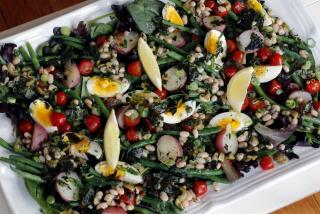Simple steps can cut deadly risk of heart disease, study finds
- Share via
For those concerned about death from cardiovascular disease, heart experts have some good news: Regular exercise, a healthy diet and five other simple measures can cut one’s near-term risk of death by more than half.
FOR THE RECORD:
Heart health: A Nov. 16 article in Section A on lifestyle measures for reducing heart-disease risk said the American Heart Assn. recommends two or more 3.5-ounce servings of fish (preferably oily fish) a day. The recommended amount is per week, not per day. —
And here’s the bad news: In a nationwide study of more than 17,820 adults, only two met all of the criteria for top-notch cardiovascular health.
The message of the study, presented Monday at an American Heart Assn. conference in Chicago, is clear, said Dr. Mark Urman, medical director of Cedars-Sinai Heart Institute’s Preventive and Consultative Heart Center.
“Boy, most Americans aren’t very healthy,” said Urman, who wasn’t involved in the research. However, he added, “on a more positive note, the study confirms that individuals can take control of their health. Incremental changes can make a huge difference.”
The changes, dubbed Life’s Simple Seven, were laid out in January as part of an American Heart Assn. campaign to guide people toward “ideal cardiovascular health.” They include:
• At least 150 minutes of moderate exercise, or 75 minutes of intense exercise, a week.
• Having a body mass index of less than 25.
• Being a nonsmoker for at least one year.
• Meeting four out of five of the association’s key components for a healthy diet.
• Keeping total cholesterol below 200 milligrams per deciliter of blood.
• Maintaining blood pressure below 120/80 millimeters of mercury.
• Having a fasting blood sugar level below 100 mg/dL of blood.
“These are the sorts of things your grandmother told you,” said Dr. Mary Cushman, a cardiovascular disease researcher at the University of Vermont, who conducted the study.
Cushman used a database of people between 45 and 84 who were already enrolled in a nationwide study on the prevalence of stroke. All of the participants had been evaluated for the factors that make up the seven criteria.
Two individuals met all seven, while 213 people were compliant with six.
Death rates for those who met at least five criteria were 55% lower over the five-year study period than for those who met none, Cushman said.
The analysis showed how much each factor mattered — for every additional criteria met, a person reduced by 15% the chance of dying in the next four years.
“That tells how powerful these things relate to heart disease risk,” Cushman said. “Being as good as you can be on all of these factors is what your goal should be.”
Americans are most compliant when it comes to maintaining healthy blood pressure and abstaining from smoking. More than 80% of those in the survey were nonsmokers, and almost 67% were in the ideal range for blood pressure, Cushman said.
On the flip side, eating a healthy diet had the fewest adherents — only 0.43% of study participants managed to do so.
The ideal diet requires meeting four of five key components based on a 2,000-calories-a-day meal plan: 41/2 cups of fruits and vegetables a day; two or more 3.5-ounce servings of fish (preferably oily fish) a day; fewer than 450 calories a week of sugar-sweetened beverages; three or more 1-ounce servings a day of whole grains; and less than 1,500 mg of sodium a day.
Cushman couldn’t identify the two people whose score was perfect. “It would be interesting to go back and talk to them,” she said, to see how they live so healthfully.
But the large number of people far from the ideal range suggests that societal, not just individual, changes are needed, she said. Public projects like parks, sidewalks and farmers markets; soda taxes; smoking restrictions and physical activity requirements in preschools and schools could move large numbers of people toward better health.





